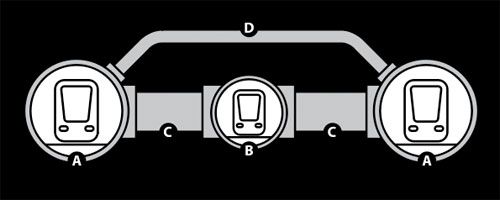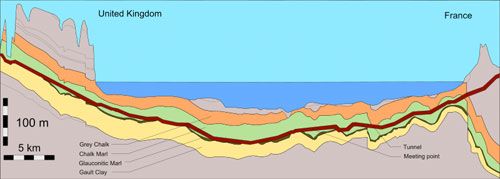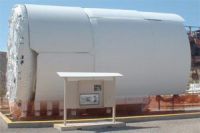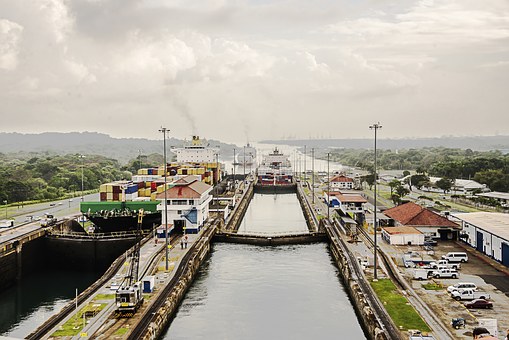The Channel Tunnel took almost two centuries to come to fruition, but on May 6, 1994, the six-year construction project became the first solid landline between Britain and continental Europe. Since then the tunnel has become a relative quick, yet somewhat expensive, form of transportation for both civilian and corporate purposes. Though it has proved less beneficial economically than expected, the tunnel still remains an engineering marvel of unprecedented ambition, labeled one of the Seven Wonders of the Modern World by the American Society of Civil Engineers in 1996.
Introducing the Idea
Though we see and use modern engineering constructs such as roads, railways, bridges, and tunnels every day, there are times when these sights leave us awestruck. Looking out the window to see a normal four lane street? Typical. Driving on an overpass spanning an interstate freeway? An everyday occurrence. But traveling over a mile-long bridge surrounded by the ocean? Now that’s a special moment. After all, who can deny that they did not gasp in awe upon seeing the Golden Gate Bridge in San Francisco or the Brooklyn Bridge in New York?
Though astonishing, these projects have an important yet simple goal in mind: to provide ease of transportation. The Golden Gate and Brooklyn Bridge decreased transportation times significantly by connecting two parts of a city separated by a body of water. However, the goals of these bridges pale in comparison to the intercontinental connection of the Channel Tunnel between Great Britain and France.
The Treaty is Signed
As early as the 19th century, British and French autocrats desired a convenient transportation system linking their two countries. Napoleon Bonaparte was even reported to have remarked, “Cest une des grandes choses que nous devrions faire ensemble,” French for “[it] is one of the great things we should do together”, to a British ambassador [1]. Geological surveys on the English Channel soon began – mostly by the French – but proposals did not move forward because of strategic implications on both sides. The British were especially concerned about compromising their natural isolation and defenses.
After World War II, however, the advent of air power convinced both sides to consider a permanent link between the two countries. Thus, detailed exploration of the region’s geology was conducted by the Channel Tunnel Study Group between 1958 and 1960, followed by a larger scale investigation from 1964 to 1965. These studies confirmed tunneling through the lower chalk stratum, a specific layer of geological sediment laid over several million years that is distinctive from those around it, was indeed possible. As a result, Britain and France began drafting a treaty endorsing the construction of a high-speed rail tunnel with a targeted opening date in 1975 [2].
During January of that year, however, Britain canceled its plan to ratify the treaty. Though the Conservative Party-led government had initially agreed to a Parliamentary Bill supporting the project, minimal progress was made because of the Party’s preoccupation with that year’s General Election. Furthermore, the election overhauled control within the government from the Conservative Party to the Labour Party, halting all progress on the tunnel project to the dismay of the French [1].
Fortunately, the newly selected Prime Minister of Great Britain, Margaret Thatcher, was willing to consider proposals for a Britain-France link that did not involve public expenditure. She and French President François Mitterrand opened an “Invitation to Promoters” in April 1985, inviting private companies to submit proposals to a specially established working group by October 31 of the same year [2].
The Winning Design
In response to the invitation, ten designs were submitted, though only four were considered adequate enough for review. These included the original tunnel design from 1975 using high speed rails, a suspension bridge composed of seven segments, a hybrid bridge-tunnel system interconnected by artificial islands, and a vehicle tunnel marked by extensive ventilation systems [2].
Two factors were deemed highly important in determining the best design: whether or not designs would interfere with maritime traffic in the English Channel and if extensive ventilation of a tunnel was feasible. The bridge-type and vehicle tunnel proposals did not satisfy these conditions and after careful deliberation, the working group decided to award the contract to the Channel Tunnel Group-France Manche (CTG-FM) venture in 1986. The Channel Tunnel route displayed in Fig. 1 below was accepted to connect the rail networks of Britain and continental Europe [2].
The CTG-FM decided against a combined rail and road system because a drive-thru tunnel not only brought up ventilation difficulties but also concerns about accident management and driver claustrophobia. Furthermore, ventilation shafts in the middle of the Channel would be hazardous to sea navigation [3]. Thus, the group’s design called for three parallel 50.5 kilometer (km) tunnels with two 7.6 meter (m) diameter running tunnels spaced 30 m apart and a 4.8 m diameter service tunnel in between them [4]. The three tunnels are interconnected at intervals of 375 m by cross passages for ventilation, safety, and maintenance; 2 m diameter piston relief ducts to alleviate pressure also connect the two running tunnels every 250 m (Kirkland, 1). A cross cut diagram of the Channel Tunnel is seen in Fig. 2.
The proposed plan listed three different transportation systems operating at 160 kilometers per hour: a drive on/drive off shuttle to carry road vehicles, a normal passenger high speed rail transport, and a freight service [2]. These services would be provided by large terminals in Folkestone, Kent and Coquelles, and Pas-de-Calais in Britain and France, respectively, and powered by an overhead line carrying a 25 kilovolt alternating current at 50 Hertz, a common standard of high speed rail lines (“Channel Electrical”, 1). Electricity usage is shared equally by the British and French power grid under normal conditions, each supplying their own terminals and half of the Channel Tunnel [2].
Digging Under the Sea
As mentioned before, geological surveys confirmed that tunneling through the lower chalk stratum layer was feasible. The chalk is resistant to penetration by groundwater because of the presence of clay, and also provides an adequate medium for tunnel boring machines (TBM), as it is more solid and less prone to fracturing and collapsing [4]. However, though this chalk stratum was quickly reachable from the British side, the geology on the French side proved more difficult, because the tunnel would have to first pass through the more brittle and water-permeable Upper and Middle chalk. This is shown on the right portion of Fig. 3. Thus, special measures would have to be taken to maintain construction standards [2].
A total of eleven TBMs (see Fig. 4 below) were ordered, with six starting from the British side and five from the French. As explained above, two different techniques were needed to address the different geological conditions. The British side used open, full-face TBMs to sheer through the solid rock [4]. Conversely, the French used full face, earth-pressure type TBMs to deal with the more fragile rock. These machines were able to maintain stability by keeping the rate of soil removal equal to the rate of machine advance, along with grouting (addition of concrete type filling) to maintain optimum tunneling conditions [2]. Once the lower chalk stratum was reached, the French TBMs were then configured to open type for boring through the solid chalk medium [4]. Immediately behind the TBMs, the tunnel was lined with 1.5-m wide concrete linings, varying between 400 millimeters (mm) to 800 mm in thickness. Cast iron was used in places determined inappropriate for concrete [5].
Though the types of TBMs used were different, the overall tunneling technique was identical. On both sides, digging of the service tunnel preceded other tunnels in order to probe and confirm geological conditions ahead of the running tunnel TBMs. Additionally, the service tunnel allowed for grout injections to improve the stability of the tunneling medium [4].
Both tunneling teams would eventually meet at a point closer to the French coast, as shown in Fig. 3. The issue that remained, however, was disposing of the immense TBMs within the tunnel. For the service tunnels, when the opposing TBMs were 100 m apart the French TBM was stopped and dismantled while the British TBM continued on for another 50 m before being turned on its side and buried. The remaining distance was dug using hand-held tools to allow for a small ceremony dedicating the historical breakthrough. The running tunnels took a reverse approach: the British TBM was buried with concrete below the tunnel floor while the French TBM tunneled through the remaining distance before being dismantled [4]. All in all, a total of 150 km of tunneling was completed between January 4, 1988, and June 28, 1991, a remarkably short span of less than three and a half years.
Maintenance and Safety Features
The running tunnels are divided into six intervals with two main crossover sections over the entire length. This allows sections of one tunnel to be maintained while service continues through the other tunnel [6]. Overall, the service tunnel serves as the main lifeline of the system if any complications arise; it provides a means of distribution of technical equipment, fresh air ventilation, and emergency evacuations.
Additionally, friction and drag of the high speed train leads to heat buildup, the amount dependent upon on the extent of track use. Though much of the heat is absorbed by the ground, a cooling system was designed with a limit of 30 °C (86 °F), or slightly above room temperature at 25 °C (77 °F). This limited temperature is maintained by a mechanical cooling system that runs chilled water through pipes within the tunnel [2].
A primary concern regarding safety and maintenance in the tunnel is the proper provision and regulation of pressure for the combined 6,600 tons of air in the tunnels. Two ventilation systems were designed – one for everyday use and the other for emergencies. The first was designated the Normal Ventilation System (NVS) and supplies fresh air at a rate of 88 m3/sec into the service tunnel and through cross passages to the running tunnels. This flow rate is enough to sustain 20,000 people in the tunnel at a time [5]. The second was designated the Supplementary Ventilation System (SVS), dwarfing the NVS capacity with a 260 to 300 m3/sec air flow rate to provide additional cooling in the event of tunnel power failure [5]. Additionally, the fans on the SVS can be reversed to control air flow if needed. The two ventilation plants are located in Shakespeare Cliff, Dover, in Britain, and Sangatte in France [6].
…But What if there is a Fire?
Precautionary measures taken to decrease risk of fires in the Channel Tunnel include banning hazardous materials and purging the vehicle of any dangerous fuel vapors before entrance into the tunnel. Fire detection units are installed in both the shuttles and tunnels, and if a fire is detected, the SVS can be used to control the flow of smoke [5].
The shuttle wagon door systems (see Fig. 5) are designed to withstand fire for 30 minutes, longer than the estimated 27 minute transit time. In the case of a fire, normal procedures are to transfer passengers into sections away from the flames and seal the fire-resistant doors. Under no condition is the train to be stopped, as the burning train will be directed to a special facility designed for passenger evacuation and fire fighting. This allows for emergency procedures to be carried out away from narrow confines and also prevents delays in tunnel operations. If the train is unable to leave the tunnel, a resident emergency reaction force is deployed through the service tunnel to evacuate passengers and fight the fire using a water main located within the service tunnel [5].
On November 18, 1996, these safety features were tested when a freight vehicle caught fire and was unable to continue above ground because of a short circuit in the power lines. Though the emergency reaction force was able to evacuate all passengers without any injuries, a sizable portion of the tunnel required extensive repair as a result of fire damage. From the post-accident report, it was determined that the detection units and the SVS were effective in detecting the fire and regulating smoke (though the second was not turned on quickly enough). However, the chance remained that a damaging fire could occur in the tunnel and brought to light the need for on-board fire suppression. Thus, a high water pressure mist system has since been installed on all shuttles [5].
The Legacy of a Six-year Project
Since 1994, the Channel Tunnel has provided an easy form of transportation between Britain and France. Though construction costs were significantly higher than forecasted at $21 billion and the economic benefits were not as positive as predicted, the tunnel nevertheless represents a spectacular feat of engineering, constructed in a period of only six years [1]. Forgoing continental shifts, the Channel Tunnel will stand as one of mankind’s greatest feats, lasting millions of years in an unchanging bed of chalk.







